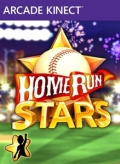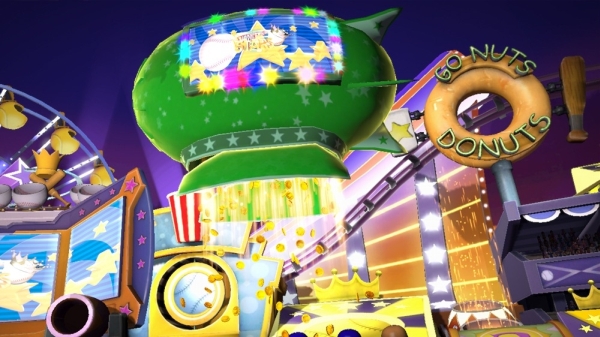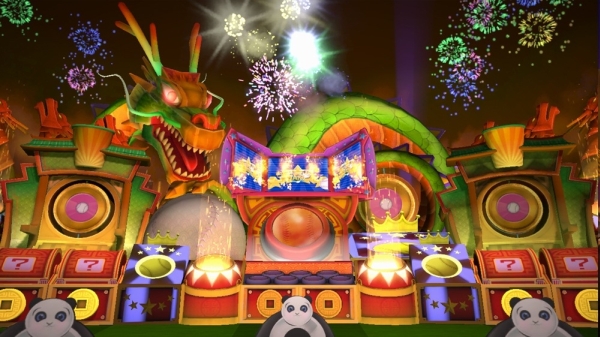
Spring 2001. Normal, Illinois. My last semester at college was peppered with preparing for graduation, studying for finals, job searching, and filming a movie about a murderous chef (don’t ask). But, like any self-respecting gamer, I always found time to relax with my PlayStation and Nintendo 64. Throughout the final month of my college career, my roommate and I put an absurd amount of time into one game: Triple Play 2001. We did not play the exhibition or season modes; our precious time was devoted to Extreme Home Run Derby, where, instead of a baseball stadium, you are placed in a giant living room, medieval castle, or construction site. The goal of that game was to not just hit home runs, but also get bonus points by hitting various targets. Shatter a picture frame in the living room, get 500 bonus points. Raise the drawbridge in the castle, get 1000 bonus points. You get the idea.
Ever since Triple Play 2001, I yearned for another baseball game to come along with the same feature. Alas, my wishes have gone unfulfilled. Now, eleven years later, we are treated to Home Run Stars, a Kinect title available on Xbox Live Arcade. One could only imagine my elation upon learning that a spiritual successor of sorts was being released. And although I found the game somewhat enjoyable, there were too many issues with Home Run Stars (and the Kinect itself) that bogged down what could have been a fantastic game.
This is one more suited for Double-A than the Majors.
Platforms: Xbox 360
Publisher: Microsoft Studios
Developer: Smoking Gun Interactive
Genre: We’re Talkin’ Baseball
Release Date: October 26, 2012
ESRB Rating: Everyone
 Home Run Stars puts your Xbox Avatar in the cleats of a baseball player and has you swinging for the fences – as well as ferris wheels, dragons, and pirate ships – to earn big points. With your Avatar at the plate, you have ten chances to hit home runs. Every time you get a strike, hit a foul ball, or hit it into the infield, you lose a ball. Once all ten are gone, it’s game over. Balls are not deducted for successful home runs, so make sure your timing is perfect.
Home Run Stars puts your Xbox Avatar in the cleats of a baseball player and has you swinging for the fences – as well as ferris wheels, dragons, and pirate ships – to earn big points. With your Avatar at the plate, you have ten chances to hit home runs. Every time you get a strike, hit a foul ball, or hit it into the infield, you lose a ball. Once all ten are gone, it’s game over. Balls are not deducted for successful home runs, so make sure your timing is perfect.
While standing at the plate, you see a cone-shaped light showing the general direction of your hit. You can change your aim by moving your front foot to the left or right. I found this to be intuitive – for the most part. There were several situations where I would move my foot slightly to the left or right, only to see my on-screen persona’s aim drastically change to the very edge of the field. While I was attempting to correct this error, the pitch was already on its way, resulting in either a strike or a foul ball.
But when you do connect, it’s awesome. Once you hit a dinger, the ball rockets through the air and you can slightly control the trajectory by leaning side to side and forward or backward. This definitely can make the difference between hitting a 1,000-point target and a 2,500-point target – and you’ll need every point to make it through the game’s league mode. Hitting certain targets will also unlock score multipliers on other targets, and once those are hit, you really rack up the points.
Hitting the ball into other specific targets unlocks powerup cards. With these cards, you can gain full control over a home run ball, unlock all multipliers, or even bring in a blimp which, when hit, earns you huge points. These cards are only good for one pitch, though. If you miss your target or whiff, you’re out of luck until you are able to obtain another card. The batter isn’t the only one who gets powerups, however. At random times, the pitcher will throw a powered-up ball – whether it’s a fiery fastball, zig-zagging electric ball, or super-slow ice ball. These super pitches may seem impossible to hit at first, but once you get more accustomed to the patterns, you should have no problem getting epic blasts off of them.

Home Run Stars includes three stadiums, each with its own theme. There’s a carnival stadium, ancient China stadium, and a pirate-themed stadium. While there is some variety to each level in terms of the targets, they don’t feel all that different. It almost seems like they were all the same basic setup but with different coats of paint. I also would have liked to see more than just three stadiums.
The game is not light on content, however. There are several modes for single and multiplayer, and online leaderboards for those oh-so-important bragging rights. Home Run Stars is also the first Xbox Live Arcade game to feature Smartglass support. Unfortunately, Smartglass was not compatible with my phone, so I was unable to try out that aspect. The multiplayer, however, is a lot of fun. Local multiplayer is restricted to back-and-forth home run derbies, and online multiplayer puts one player as a pitcher and the other as the batter. Playing the game against friends is always welcome, so no complaints there.
The core game itself is fun, but unfortunately problems with controls make a potentially great game extremely frustrating. I’m not sure if this issue lies in the game or the Kinect itself, but either way, it’s aggravating. From the very beginning, there are interface issues. First, there is no “floating hand” when navigating the menu. In most, if not all, Kinect games, the location of your hand is interpreted as a pointer on the screen, so you can easily make your selections. In Home Run Stars, you move your hand around until the option you wish to choose lights up. I spent way too much time accidentally selecting a stadium I did not want to play, then had to go back to the main menu and wave around to get the correct selection. Why this was not included confounds me.

The gameplay isn’t perfect, either. Most of the time – I’d say 85% – your swings are accurately recognized. But it’s that other 15% of the time that is infuriating. I can’t tell you how many times I’ve been just a few points away from earning a medal, only to have a perfectly-timed swing not register in the game and lose a turn. At one point I was actually screwed out of earning a bronze medal (and thus accessing the next level) on my final pitch due to this error. I was so livid that I threw a Brian Wilson-inspired tantrum and beat the hell out of my couch with a Fisher Price baseball bat:
Making matters worse is the difficulty curve in League Mode. It starts off simple enough – you square off against one pitcher, and once you earn enough points to get a bronze, silver, or gold medal, you are move on to the next pitcher. Once you win against three pitchers, you move on to the next stadium. With each pitcher, the points required to move on to the next increases. By the time you get to the end, the required points are so high that it becomes quite literally an exercise just to barely scrape past bronze medal status. Couple that with the recognition issues and you’re left with a game that gets, at times, unbearable.
This is not to say the game is awful; it’s actually quite good at times, and I even had some fun. Hitting home runs and moving around to try to land the ball through the middle of a giant donut is enjoyable. Playing against your friends (both on- and offline) to earn high scores is a blast. When it works, Home Run Stars hits it out of the park. Unfortunately, this does not happen all the time, and gets very discouraging (especially for kids, who are this game’s target audience).
Frustrations aside, I still hope that we get to see Home Run Stars 2. If the developers can keep what makes the first game so much fun, add some more variety to the stadiums and targets (see the above-mentioned Triple Play 2001), and most importantly, give us an option for controller support, then we can see a truly phenomenal game. Until then, Home Run Stars is just barely tagged out at home plate.

Review Disclosure: A review copy of Home Run Stars was provided by Microsoft Studios for the purposes of this review.







